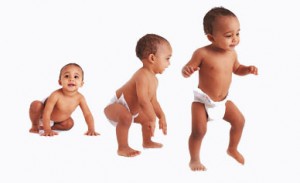Your Child’s Development Milestone: Identifying Normal Growth
By Dr Khoo Boo Aik, Consultant Paediatrician and Neonatologist, MD (UKM) MRCPCH (UK) AMM
Sunway Medical Centre & QHC Medical Centre
 Watching their children grow is a pleasure that parents enjoy. It is common for parents to feel both anxious and excited for their babies to develop normally. This chapter will explore the milestones in a normal child’s development to enable parents and caregivers to identify signs of delay in their child’s progress and begin early intervention.
Watching their children grow is a pleasure that parents enjoy. It is common for parents to feel both anxious and excited for their babies to develop normally. This chapter will explore the milestones in a normal child’s development to enable parents and caregivers to identify signs of delay in their child’s progress and begin early intervention.
What are the areas of development that I need to focus on in my child?
There are four important areas in a child’s developmental milestone that requires your attention:
- Gross motor skills – ability to move around in their environment, from rolling over to crawling, walking, running, climbing, cycling, etc.
- Vision and fine motor skills – ability to use hand-visual coordination to complete certain tasks, e.g., stacking cubes, threading beads, feeding himself/herself, writing, drawing, etc.
- Hearing and speech – ability to communicate and react with the surroundings through speech.
- Social and behavioural skills – ability to interact with his/her peers, siblings and parents, and display maturity in handling social needs such as toilet training, social mannerisms, etc.
What should every parent know regarding their child’s development?
- Every milestone has its range of normality. Allow some time for your child to acquire certain skills as some children achieve certain milestones later than others.
- It is important to know the range of normality in order to detect abnormality.
- Children should be given enough time to perform under non-stressful environments or expectations.
- Every child is unique and each one develops and grows at his own pace. What’s most important is to track that the child is making progress in the four developmental milestones listed above.
- As a parent, you know your child best and your first instinct is often reliable. Talk to your paediatrician or bring your child for an assessment if you are concerned about his progress. Don’t wait.
- If your baby was born prematurely, his or her development milestone should be assessed according to the corrected age (corrected for prematurity) instead of the chronological age, until your baby reaches at least two years of age.
- The term “normal variant” describes some forms of developmental milestones that are not commonly seen in children, but which ultimately follows the normal pattern of progression. “Bottom shuffling” is a good example – babies who bottom shuffle will sit upright and move on their bottoms, usually by pulling themselves forward by their heels. From this position, they will skip the normal crawling pattern and immediately learn how to walk and run as any normal child.
What is Normal Development Milestone?
| Age | Gross Motor | Vision and Fine Motor | Speech and Hearing | Social and Behavioral |
| 1 month – 6 weeks | Head lag present. Raised hip and knee. |
Fixates and follows moving objects to 90 deg. | Quiet to soothing sound.Startles at noise. | Smiles responsively. |
| 2 – 3 months | Fairly good head control and lifts head up 45 – 90 degrees when prone. | Follows moving objects from side to side(180 degrees).Grasps object placed in hand. | Turns head toward sound.Makes gurgling sounds and squeals with delight. | Social smiling.Interested in parents’ face. |
| 4 – 6 months | Rolls over prone to supine. Pushes up to elbow when lying on stomach.Bears weight on legs. |
Reaches out for toys and can transfer between both hands. | Begins to babble with expression.Copies sounds. | Likes to play with people.Laughing when playing. Mouthing (puts things into mouth). |
| 7 – 9months | Sits unsupported.Attempts to crawl and pull to stand. | Banging things together.Immature pincer grasping (scissor grasp). | Polysyllabic babbling.Copies sounds. | Looking for things that fall or to hide (object permanent).Plays peek-a-boo. |
| 10 – 12 months | May stand alone and walk while holding on to something. (cruising) | Takes things in and out of container.Drinks from cup.Points with index finger.Neat pincer. | Able to say papa, mama, no, bye-bye.Responds to simple command. | Helps with dressing.Draws attention. Cries when mom/dad leaves.Waves bye-bye.Casting. |
| 2 – 2.5 years | Goes up and down stairs two feet per step.Runs steadily.Kicks ball.Jumps on both feet, walks tip-toe. | Builds tower of 6 – 8 cubes.Holds pencil well.Imitates horizontal and vertical line. | 2 – 3 word sentences, uses you, me, I. Points to 4 body parts.Knows full name and gender. |
Puts on shoes, socks, pants.Dry during day. |
| 3 years | Rides tricycle.Goes up stairs one foot per step, down stairs, 2 feet per step. | Builds tower of 9 cubes.Copies circleImitates cross. |
Turns door handle.
Screws and unscrews jar lid.Names 2 colours.Counts to 10.Can sing nursery rhymes.Understands ‘on’, ‘in’ and ‘under’.Dresses and undresses self.Dry during night.Take turns in games.
Plays make-believe with doll.4 yearsGoes up and down stairs one foot per step.Skips and hops on one foot.Copies cross.Draws man with 2 – 4 body parts.Uses scissors to cut papers.Names 3 colours.Fluent conversation.Understands ‘in front of’, ‘between’ and ‘behind’.Buttons clothes fully.Attends to own toilet needs.More creative with make-believe play.5 yearsSkips on both feet.Runs on toes.
Stands on one foot for > 10sec.Copies “X”, triangle.Draws man with at least 6 body parts.Knows age.Name 4 colours.Tells the time.
Tells simple story.
Tells address.Ties shoelaces.Aware of gender.
Can tell what is real and what is make-believe.
6 yearsWalks heel to toe.Kicks, throws, swings and climbs.Copies diamond shape.Copies steps with 10 cubes.Speaks very clearly with full sentences.Uses future tense.Independent in most of the daily chores.Shows concern and sympathy for others.
What does ‘developmental delay’ mean?
Doctors use this term when a child doesn’t reach his developmental milestones within the broad range of what’s considered normal. The delay might be in one area, for example, isolated speech delay; or involve all the four areas, which is termed global development delay (GDD).
When should I worry about my child’s development?
In most instances, babies reach each their developmental milestone (like rolling over, sitting, walking, and talking) right around the expected time, and if they don’t, they catch up soon. On the other hand, spotting potential problems sooner rather than later is important if your baby does have a genuine developmental delay. If you notice your child’s development is static (not making progress) or regressing from his or her already acquired abilities, you should bring him or her to a paediatrician immediately for a proper assessment.
Here are some tips to look for to identify potential delays or problems in your child’s development:
- Gross motor
– General floppiness – poor head control after three months old.
– General stiffness – holds his/her fist tightly and frequent arching of the back.
– Unable to sit by one year old.
– Unable to walk by 18 months.
- 2. Vision and fine motor
– Not focusing on mother’s face by one month of age with eye rowing around may suggest visual impairment.
– Shows hand preference (consistently favouring one hand over the other) before the age of two may indicate weakness or stiffness of the lesser used hand.
–
– Absence of mature pincer grasp (thumb-index finger grasp) by one year of age.
- 3. Hearing and speech
– Showing no response to loud sounds may indicate hearing impairment.
– Delayed speech with no meaningful words by two years old
- 4. Social and behavioral skill
– Appears “clumsy” – inability to perform simple physical tasks smoothly and efficiently according to age ability.
– Poor concentration with hyperactivity.
– Poor eye contact; prefers to be alone and refuses to be hugged or cuddled.
– Repetitive hand movements such as hand flapping and head banging.
Ways to enhance your child’s developmental skills
- 1. Gross Motor
– Provide a safe environment for learning and exploring, i.e., no sharp edges or corners.
– Avoid the use of bouncers or walkers as they are more prone to causing accidents and injury. Putting babies on a flat surface will also encourage them to explore their bodies more naturally.
- 2. Vision and Fine Motor
– Encourage touching different textures at an early age.
– Encourage stacking the cubes/blocks and playing with clay and pegs.
– Encourage them to dig, paint, sweep, pour and thread beads.
– Allow your toddler to draw and scribble on paper, white board or wall.
- 3. Hearing and Speech
– Look into your baby’s eyes and talk to him/her.
– Read story book aloud to your child daily.
– Read nursery rhymes and sing nursery songs.
– Name the objects surrounding your home.
– Introduce flash cards or picture books.
– Let your children see you reading daily and they will follow suit. 
- 4. Social and behavioral skill
– Create positive body contact such as hugging and kissing.
– Encourage your children to share toys with one another and with their friends.
– Teach them to wait for their turn.
– Build their self confidence – allow them to help in your daily chores.
– Let kids figure things out themselves – allow them to decide.
– Let your children respond by themselves and avoid the urge to speak for them.
In conclusion, it is important as parents to know the range of normality in your child’s developmental milestone. This will help you identify and detect any early sign of delay or problems in your child social behavioral skills so that early diagnosis can be made and early intervention programmes can be offered to optimise your child’s potential developmental outcome.







